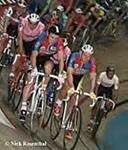 There are many events that take place on the track. While this doesn't cover the complete variation of track disciplines, most are covered and can be broadly classified into "sprint" and "endurance" events. For the newcomer to the sport, or even experienced observers, certain track cycling events can be a complete mystery. The following is a potted description of the races. There are many events that take place on the track. While this doesn't cover the complete variation of track disciplines, most are covered and can be broadly classified into "sprint" and "endurance" events. For the newcomer to the sport, or even experienced observers, certain track cycling events can be a complete mystery. The following is a potted description of the races.
Sprint events
Match Sprint (Men/Women)
Traditionally held over 1000m, this event captures the essence of track cycling, although it is the most mysterious. Although it is normally a one-on-one event, earlier rounds can feature three or more cyclists on the track at the same time. One rider is designated to lead for the first lap (usually by a coin toss), and can not relinquish it unless those behind take it from him/her. The competitors typically eye each other off for the first 6-700 metres, trying to maneuver each other into an unfavourable position, before launching an explosive sprint for the last 200 metres, which is the only part of the event that is timed. The first across the line wins the race. 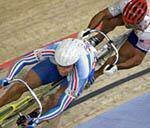
Tactics are the key to this race, and many people wonder why it is so slow for the first two laps. The main reason is that unless you can surprise your opponent early, you will waste too much precious energy in starting your sprint from lap one. If the other guy is on your wheel, it's all over.
An important rule is that of 'possession' underneath the sprinter's line, a line marked 80 cm from the pole line near the base of the track. A rider who positions themselves below this line in the final 200 metres is not allowed to be forced out by another rider e.g. pushing in from the inside. This is one of the most often broken rules causing reversals in sprint results.
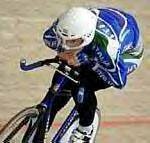 1,000 m Time Trial (Men) 1,000 m Time Trial (Men)
Probably the most painful of track disciplines, the "kilo" as it is known commonly is raced as a time trial over 1000 metres. To do well in this event you have to have an explosive start, good top speed, and endurance to carry you through the last few hundred metres where the lactic acid buildup in your legs becomes almost intolerable.
The current record is just over a minute, held by Arnaud Tournant of France. In this event, two riders often start on opposite sides of the track although it is essentially an individual event.
500 m Time Trial (Women)
Held over half the distance of the men, the women's 500m time trial requires explosiveness as well as good top speed. Typically, the fastest 200m rider is also the best over 500, although this is not always the case. It is different to the men's race with respect to the endurance required.
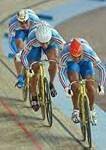 Olympic Sprint (Men) Olympic Sprint (Men)
A three man time trial held over three laps of the velodrome, with teams starting on opposite sides of the track. After the end of each lap, the leading rider pulls off completely, leaving the next to fight the wind. Therefore, the first rider has to do one laps, the second, two laps, and the last rider three laps. Hence, rider number three typically has the best endurance: A good kilometre time trial rider e.g. Arnaud Tournant or Shane Kelly is chosen for this position.
2000 m Keirin (Men)
The keirin is a motorpaced event that is very popular in Japan where it originated. In that country, huge amounts of money are bet on races and professional keirin riders command impressive salaries.
It is similar to the match sprint, but features 6-8 riders on the track. A derny motorbike paces the riders from 25 km/h up to 45 km/h for the first few laps. During this time, riders jostle each other for the best position and this is often the roughest part of the event. With two and a half laps to go, the derny bike pulls off and the sprint is on. Team tactics are important here, as the leadout is often quite long. If one team can get two of their riders in the final, then they are at a distinct advantage.
Endurance events
Individual Pursuit (Men/women)
Held over 4000 metres for elite men and 3000 metres for elite women (shorter for masters riders), this is considered an "endurance" track event, although the speeds are still extremely high. Two riders start on opposite sides of the track and try to set the fastest time over the allotted distance. Normally, a qualifying time trial is ridden that determines who is eligible for the semi finals and finals. The fastest ride is often produced here, as in the finals, the only important criterion is to beat your opponent. If one rider catches the other, i.e. puts half a lap into them, then the race is over.
An explosive start is not critical (but it's handy to have), however the ability to ride at a consistently high speed is far more important. Many riders who go out too hard can look to be well up on their opponent, only to fade in the last 1000 metres. This has typically the greatest "cross-over" to the road. i.e. good pursuiters make good road riders and vice versa. Stuart O'Grady, Vjatcheslav Ekimov, and Chris Boardman are a few examples of top pursuiters who have had successful road careers.
 4000 m Team Pursuit (Men) 4000 m Team Pursuit (Men)
This event is raced by the men only, and held over 4000 m. Faster than the individual pursuit, although it is still an endurance event, the team pursuit is about clockwork precision as well as high speed. Two four man teams start on opposite sides of the track and try to set the fastest time over the distance as with the individual pursuit. The time taken is on the third rider to cross the line.
Riders must follow each other at a few cm difference to gain the maximum drafting effect from the rider in front. Following a wheel closely is a vital skill, but stuff-ups still happen, as the Ukrainian team showed at the 1997 Worlds in Perth. A wheel touch in the final brought down the whole team down and cost them the event.
Turns of pace are often half a lap, although the stronger riders can do full lap turns. The world record for this event was set by Germany in 2000 and is over 60 km/h!
60 km Madison (Men) 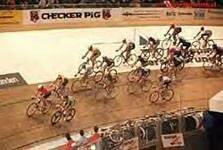
This race is named after Madison Square Garden in New York where the event was first held (also called "Americaine" in French. Two man teams contest the event, which is typically 50-60 kilometres. After a mass start where all riders are on the track, only one rider from each team is allowed in the race at a given time, meaning that teams must take it in turn each lap (or more) to have a rider in the race. Changeovers are quite dangerous, but impressive to watch when done well - one rider circles around waiting for his teammate, who joins hands and imparts his momentum to the slower rider.
To win the madison, the team must score points by sprinting every 20 laps for bonuses (5, 3, 2, 1 points). The last lap counts for double points, but the winner of this does not necessarily win the event. Also, if a team can gain a lap on the field, then they are in the leading position of the race no matter how many points they have.
Points Race (Men/women)
This is a solo event, scored similarly to the madison and raced by both men and women. Again, a rider scores points in intermediate bonus sprints every 10th lap (5, 3, 2, 1) with double points awarded on the last lap. If a rider can lap the field, then they win the race.
The Hour Record (Men/women)
 One track event stands outside and above typical track events: the hour record. I know about this one because I'm happy to say I know Chris Boardman. The Hour Record is a simple test of ability to cover distance in 60 minutes and both UCI and Absolute records are currently held by Chris Boardman. In 1996, Chris rode 56.375 kilometres around Manchester velodrome using the now outlawed "superman position". In October 2000, he rode 49.441 kilometres on a UCI standardised bike: a steel tubed triangular frame with spoked wheels and no aero helmet and then retired!!! One track event stands outside and above typical track events: the hour record. I know about this one because I'm happy to say I know Chris Boardman. The Hour Record is a simple test of ability to cover distance in 60 minutes and both UCI and Absolute records are currently held by Chris Boardman. In 1996, Chris rode 56.375 kilometres around Manchester velodrome using the now outlawed "superman position". In October 2000, he rode 49.441 kilometres on a UCI standardised bike: a steel tubed triangular frame with spoked wheels and no aero helmet and then retired!!!
Traditionally, only great riders at the peak of their careers attempted the hour record. Eddy Merckx' 1972 record stood for 12 years until being broken in 1984 by Francesco Moser: both were international superstars at the height of their powers. This all changed in 1993 when Graeme Obree, an unemployed Scotsmam riding a home-made bike in a bizarre, folded-up riding position added 400m to Moser's record. Over the next three years the record fell six times. Chris's record was set in the radical, highly aerodynamic 'Superman' position, invented by Obree when his tucked position was banned.
Both women's hour records are held by French great, Jeannie Longo, who rode 48.159 kilometres in 1996 (Absolute Record) and 44.767 kilometres in 2000.
|